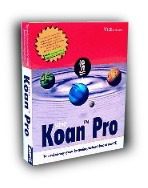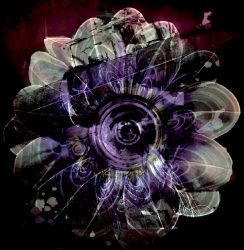
2006 celebrates the 10th anniversary of a musical revolution that hardly anyone noticed.
In 1996, a company called SSeyo released the first version of their KOAN musical software. An incredible ingenious piece of work that introduced the concept of “Generative Music” – music that chooses it’s own path from a set of rules and parameters, and sounded slightly different every time it is played.
The program literally had hundreds of sets of musical rules built in, from which the composer could choose and build a set of rules from which the program would choose. A simple rule could be something like the length of the composition: a bit like “minimum length is 4 minutes but the range is 6 minutes” (meaning the length of the composition was a different in length each time, duration could be anything between 4 and 10 minutes).
Another parameter, for example, could be the piece root: “when starting the piece, choose between C or D of E, but with a 50% more chance of choosing D than C, chance of choosing E is no more than 10%”.
Or the scale, or the instruments, or the harmony rules…or…or…or combinations of all that….
This definitely was NOT a program for Control Freaks! If you wanted to have it the difficult way, you could easily get lost in the endless possibilities. But on the other hand, one could get fascinating results without exactly understanding what one was doing…
It was no surprise that Brian Eno was one of the early adopters of this system. In fact he had already created his own “Generative Music” for years for his installations: by randomly playing samples on 8 (or more) cd-players playing simultaneously.
Eno’s “Generative Music”, released in 1996 on a single diskette, was a masterpiece that most of his fans have never heard. It’s music illustrates the power of KOAN when used by someone who knew what to do with it.
The good news is: this masterpiece is still available!
The bad news, however, is that you will never hear the music as it was intended, unless you can run a computer using a Creative Soundblaster AWE32.
The music was written to use the MIDI patches that were exclusively available on that soundcard. Newer soundcards, using other MIDI samples, sounded dramatically different – introducing a generativeness múch less appreciated!!
This hardware dependency of the software was one of its biggest mistakes. Later versions could load ‘soundfonts’ or MP3-samples, so the music could still be re-created independent of the hardware. But somehow, in spite of all prizes and recognition the SSEYO company gained, the concept never really catched on.
It simply was way too much ahead of the rest of the world…
SSeyo moved on to the realm of ringtone production…somewhere I have never tried to followed them. But they still exist, which means that the old KOAN programs are still there. KOAN Pro and KOAN X (the “easier” version with a graphic user interface) are still available and still work fine with modern operating systems.
It’s 10 years later now. Maybe it’s time to re-invent the revolution of Generative Music.
Please note that the examples below is a recorded version of the piece, and therefor it is not ‘generative’.
Brian Eno – Methane IV (from “Generative Music I”):



I saw this, and thanks for the mention of Koan. Hope you are well…..
NB: On the “ringtone side”, miniMIXA is actually a “music mixer”, and it also includes support for Koan tracks, meaning it can mix Koan tracks with audio loops etc. See http://www.minimixa.com. There are versions for desktop, too. miniMIXA is powered by Tao intent and it contains support for an “improved” soft synth to the one used in Koan Pro, but we have yet to be able to release a tool to allow use of this.. When that is available, it should be possible to construct Koan pieces with Koan Pro, and then attach sounds/synth settings etc to them so they can play in miniMIXA (other than just as MIDI). The reason Koan sounds were (before the softsynth) dependent on audio hardware was simply that at that time, that was the only route to go for quality audio. Of course, today everything is different and there are many powerful softsynths available….
NBB: I think the AWE64 was as good as AWE32? Audigy and SBLive may have been a bit harsh, but they still should be sort of OK. I think? they still include the SoundFont Bank that was the basis for GM1, and I thought they still supported the same NRPNs.
NBBB: Eno is still using Koan. I met up with him last week….
NBBBB: 10 years ago. Amazing…. It would be GREAT if Opal would release an actual recording of GM1. People would at last be able to hear it (even if not in the full generative way), and so appreciate what was done 10 years ago by Eno… Maybe if enough people ask….
Thanks for your support and goodwill over the years. It has been a long haul…..
Thanks – the link is corrected in the original post, too.
You’ve provided a bad link – HTH! http://http//www.sseyo.com/products/koancontent/genmus1.html
Should be to:
http://www.sseyo.com/products/koancontent/genmus1.html
Thanks for that compliment
I thought the GM pieces played on my SBLive card were somewhat harsh and tinny sounding, so your description of the SBLive as “harsh, metallic sounding” is consistent with my experience as is the sample you recorded. I played it while playing also playing the GM track I have and switched back and forth and the difference is sound was very clear.
‘Sketch for Dark Values’ is very nice, by the way. Good title for the dark atmospheres.
[quote]The lower speaker icon has tracks that are definitely not on GM1.[/quote]
You’re right, but obviously you don’t see the mouse-over texts? The lower speaker icon plays tracks I created myself…hahaha…these DEFINITELY do not belong on GM1.
I’ll correct this in the original post so that it is clearer even without the mouseover…
The upper speaker Icon Track is Methane IV from Generative Music I, directly recorded when playing on a PC using the Soundblaster AWE32. The fact that you do not recognise it stresses the example of how much the soundcards differ in the result…let me know which one you think sounds better!
Peter
I have a confession to make…one of the REAL reasons I bought my first PC in 2000 was just so I could actually play my copy of Generative Music, I have been trying since then to copy it to CD just so I could hear it through some decent speakers, without any success!
I couldn’t get the Eno recommended sound card so I had to make do with Sound Blaster Live, so I don’t know what I’m missing.
What is the upper speaker icon track? I don’t recognise it and I would very much like to compare how it sounds with my version.
The lower speaker icon has tracks that are definitely not on GM1.
Tony
Hi Mark.
Compared to it’s successor, the SBLive, the AWE32 tracks sounded much ‘softer’. The SBLive was harsh, amost metallic sounding. Other soundcards may have other results. The sample track above (the upper speaker icon) is recorded on AWE32, just try to compare it to how it sounds on your computer, and let me know how it sounds with you?
Bye
Peter
From what you write post I gather that you have the correct soundcard (or have listened to the pieces on a system with that soundcard) and so you have heard the difference between the intended versions and the versions heard by those of us who do not have that soundcard. I am in the latter category. Are they really dramatically different? How so? I’m curious.